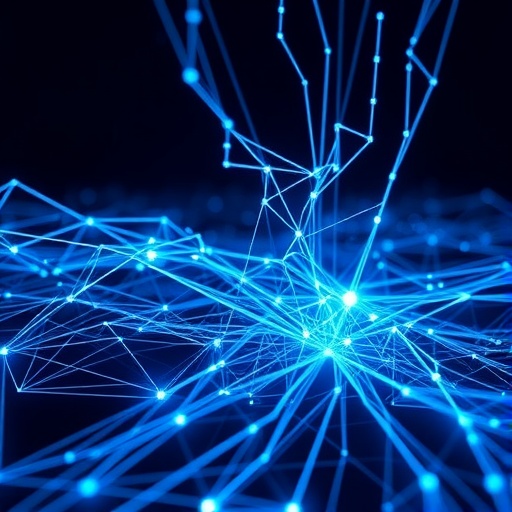The rapid evolution of artificial intelligence (AI) heralds an era of unprecedented data demands, pushing the limits of current infrastructure to its brink. As the AI boom continues unabated, challenges arise in the form of increasing data traffic, electrical consumption, and the looming specter of quantum security threats. These threats pose a significant risk to traditional encryption methods, potentially rendering them obsolete in the face of advanced quantum computing capabilities. In this context, the quest for innovative solutions that address these multifaceted challenges has become more urgent than ever.
A groundbreaking study published in Advanced Photonics presents a novel architecture designed to secure data transmission in AI-driven data centers, while minimizing the need for extensive digital signal processing (DSP). This pioneering framework not only addresses the high-speed requirements of modern data applications but also fortifies against the potential vulnerabilities introduced by future quantum technologies. In an age where the integrity of data is paramount, such innovative approaches could mark a significant leap toward secure, scalable, and energy-efficient networking.
With the ambition to deliver data at terabit-per-second speeds while simultaneously curbing power consumption, the researchers have meticulously designed a system that integrates classic data transmission techniques with cutting-edge quantum key distribution (QKD). The incorporation of self-homodyne coherent (SHC) transmission allows for enhanced reliability and efficiency in data signaling. By embedding a reference signal alongside the data being transmitted, the architecture simplifies decoding at the receiving end, achieving stellar performance metrics without skyrocketing costs or energy usage.
The security strategy employed in this novel architecture centers around the application of QKD, leveraging the innate properties of quantum mechanics to generate secret encryption keys. Unlike classical encryption methods, which are vulnerable to interception, these quantum-generated keys remain unbreachable, ensuring secure communication channels via advanced AES-256 encryption. The implications of such a system are profound, as it promises to secure sensitive data against potential attacks from quantum computers, which threaten to undermine conventional encryption practices.
In practical terms, the system utilizes multicore fibers that accommodate separate channels for various signal types, allowing seamless coexistence without interference. This enables the efficient transmission of both classical data and quantum signals within a single fiber-optic infrastructure, a crucial feature for facilitating a smooth transition to more robust and secure networking models.
Initial laboratory experiments deploying a seven-core fiber have yielded promising results, demonstrating the viability of transmitting classical data at speeds surpassing 1.6 terabits per second while simultaneously executing quantum signal operations through QKD. The experiments indicated an average secret key rate of 229 kilobits per second, thus supporting encrypted data transmissions at a rate of 400 gigabits per second across each fiber core. Such performance illustrates the architecture’s extraordinary potential to revolutionize data transmission protocols.
A comprehensive 24-hour test was conducted, simulating real-world conditions over a 3.5-kilometer stretch of fiber. During this continuous trial, the system successfully aggregated 2 terabits per second of classical data traffic while simultaneously maintaining an average secret key rate of 205 kilobits per second. This significant throughput resulted in the generation of approximately 583 secure encryption keys every second. In total, the system managed the encryption and decryption of over 21.6 petabits of classical data in real-time without encountering a single error, showcasing its reliability and robustness.
This architecture stands out not only for its speed but also for its dual focus on efficiency and security. The combination of photonics with quantum cryptography effectively addresses the transmission losses and bottlenecks that plague existing systems, paving the way for viable solutions tailored to the exponential growth in data traffic anticipated in the coming years. By marrying innovative photonic technologies with quantum cryptographic principles, researchers are opening avenues for the design of networks that can uphold the rigorous demands of the modern data landscape while offering formidable defenses against emergent threats.
Ultimately, the findings and methods put forth in this study herald a promising direction for the field of data transmission, providing a framework capable of meeting the escalating demands generated by AI applications, autonomous systems, and expansive cloud architectures. As we venture further into the age of digital transformation, the significance of secure, efficient communication infrastructures will only grow, necessitating further exploration and adaptation of these groundbreaking technologies.
The potential applications of this research extend beyond mere data transmission. The methodology described could find usage across various domains, including secure communications for financial institutions, governmental data systems, and critical infrastructure, thereby enhancing security in sectors where data breaches can have catastrophic consequences. The exciting synergy between photonics and quantum technologies stands to shape the future landscape of global communications, ensuring integrity and confidentiality in a world increasingly reliant on digital pathways.
As additional research unfolds in this rapidly evolving field, it is clear that innovative solutions like the quantum-secured DSP-lite architecture could redefine our approach to data security and transmission. This study not only lays the groundwork for future explorations in optical interconnect systems but also sets a precedent for how we might address the complex interplay of technological advancement and security in an ever-growing digital landscape.
In conclusion, the intersection of photonics and quantum cryptography marks a significant milestone in the pursuit of secure, efficient data transmission avenues. As the field continues to evolve, exciting possibilities lie ahead, poised to transform how we secure and manage the monumental flows of data that underpin our burgeoning AI-driven future.
Subject of Research: Quantum-secured data transmission architecture for AI-driven data centers
Article Title: Quantum-secured DSP-lite data transmission architecture for AI-driven data centers
News Publication Date: 17-Oct-2025
Web References: Advanced Photonics
References: X. Ji et al. (2025). Quantum-secured DSP-lite data transmission architecture for AI-driven data centers, Adv. Photon., 7(6), 066006, doi: 10.1117/1.AP.7.6.066006.
Image Credits: X. Ji et al., doi 10.1117/1.AP.7.6.066006.
Keywords
Quantum cryptography, Optical interconnects, Artificial intelligence, Data transmission, Quantum key distribution, Photonic technologies.




